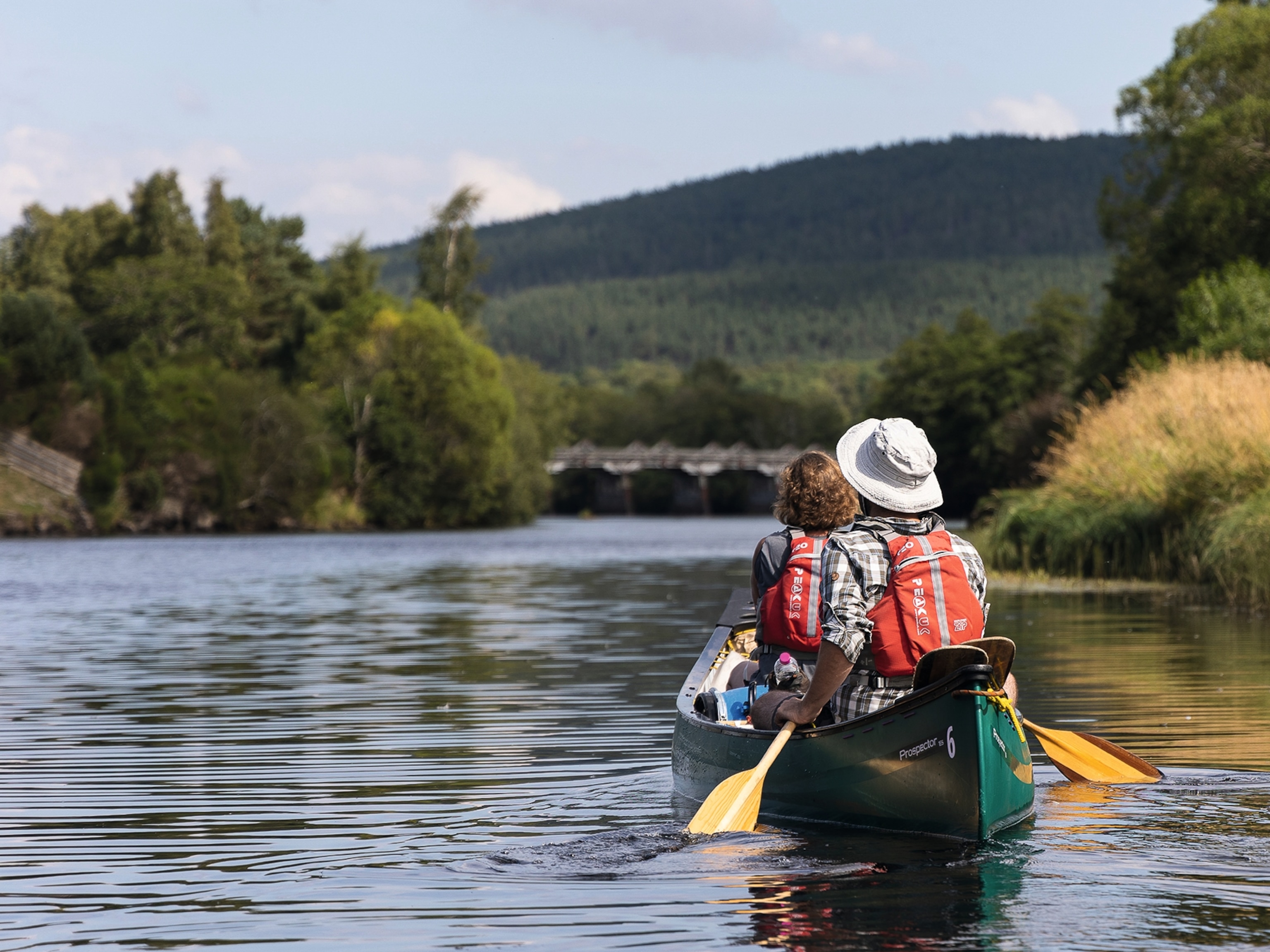














China’s Mystic Waters
Visitors are enthralled by the Jiuzhaigou reserve.
Jiuzhaigou means "valley of nine villages," because it once harbored nine, but other numbers are more significant now. About 80 hotels are clustered cleanly at the mouth of a Y-shaped, 20-mile-long valley in the Min Mountains of central China, where 280 buses wait to shuttle this day's 18,000 or so visitors up the very pretty route, past a chain of flower-colored, ribbony lakes and fingery waterfalls, underneath escarpments chevroned with maple, spruce, or bamboo forests cut by the talus of old landslides. (Clouds permitting, it's just a 40-minute flight from Chengdu, the tree-shaded jumping-off point in Sichuan Province nestled near some of the major germinating sites of China's civilization 3,000 years ago.) Boardwalks circuit the little lakes and reedy creeks, and the buses stop to let parties of trippers stroll at their own pace. Then they queue to catch another and continue on.
Glaciers carved the two valleys that join the Shuzheng Valley—the Zechawa and the Rize, which climb to around 10,000 feet—into the classic U shapes one knows from Yosemite, Jiuzhaigou's "sister" park in the United States, with walls that discourage casual scrambling yet do not tower severely enough to distract from the extraordinary limy beauty of the modest waterways underneath. The geology in this part of the Tibetan Plateau is not granite, like the Sierras, but seabed, like our Rockies, so its limestones, dissolving, color the waters emerald or turquoise in a certain light or enhance the mirroring of an azure sky. Avalanches, in blocking the creeks, sculpted the lakes, but by legend, sky goddesses dropped their cosmetics into several, and mermaids swam in others. Calcium carbonate deposits on the bottom sometimes assumed fanciful shapes—sleeping dragons or whatnot.
The road ascends from about 6,000 feet at the valley entrance, splits at Nuorilang, where a tourist shopping center and cafeteria are set up, and terminates in the case of the left fork at a wilderness lake, wiggly and long, and in the case of the right at a "primeval forest," in the language of the brochures, which translates as groves that were not leveled by loggers before the area's tourism possibilities were recognized. Jiuzhaigou Nature Reserve, China's flagship of its type, was designated a World Heritage site in 1992 by UNESCO, after logging sprees threatened to degrade it.
Costumed Tibetans sell trinkets and postcards at the end of each fork, and the boardwalks loop more ambitiously than usual. Along the bus route there's a Golden Bell Lake, Grass Lake, a Pearl Shoals Falls, Arrow Bamboo Falls, a Five Flower Lake and Five Colored Pond, a Sparkling Lake, Tiger Lake, Bonsai Lake, Swan Lake, Rhinoceros Lake, Double Dragon Lake, Reed Lake, Panda Lake, and Mirror Lake, which reflects, as the others do, the menagerie of the clouds, the birches, willows, and pines, the tinctures and hues of sunrise and sunset on rock faces and cliffs. Five shades of green, three of scree. Although the names sound promotional, Buddhist mysticism, and certainly the Bon religion that predated it and underlies it for many Tibetans, animated these lakes and rivers with spirits that the mineralized waters might fortuitously personify, whether mermaid or monster.
A flyer explains that the myriad lakes and tarns of Mount Wonuosemo and Mount Dage resulted when "the goddess Wonosmo dropped a mystical mirror, a gift of love from the god Dag." The true Tibetan narratives no doubt had more intriguing meanings attached to them, a spectrum equivalent to the colors this upthrust seafloor's chemistry bestows upon the waters flowing through. The Baihe, or White River, rustles by the park's entrance to join the White Dragon River (named for a bluff), and then the mightier Jialing, and finally the gouged and mangled, gigantic Yangtze itself.
The intensely lovely little Jiuzhaigou complex of chromatic lakes in glacially awled mini-valleys is already nearly bereft of the tubby black-and-white pandas that once thrived here—an animal now trumpeted by the government as "our national treasure" but displaced wholesale by heedless logging and a die-off of bamboo during the last decades of the past century; more than one Tibetan described the decimation to me. Masticating bamboo shoots in a semireclining position, like a sea otter munching mollusks while lounging on its back, the panda has become an endearing emblem for conservationists worldwide and carries a heavy load in this supercharged robber-baron economy. Conservation would be a novel concept to anyone unacquainted with what is supposed to be preserved, such as wildness, wildlife, natural beauty. I noticed at the Beijing Zoo that the visitors seemed to have no feeling one way or another for the apparent thirst of the bears in their waterless pit or the metronomic jackals and wolves ticktocking in the heat. In the greenery of Chengdu's parks, the din of birdsong was so frenetic and dense as to imply an extreme scarcity of nesting spaces elsewhere. Only recently did the People's Republic bar the serving of delicacies like bears' paws at official government banquets, about the same time the Dalai Lama, in his Indian exile, urged his followers to end the wearing of tigers' or leopards' skins. Edicts can't generate a conservation ethic, however. Jiuzhaigou's chief scientist told me he still found snow leopard skins openly displayed for sale nearby in Songpan for the equivalent of a hundred bucks—a month's wages for a laborer. And in Jiuzhaigou's Zaru Valley—less developed than the Shuzheng, where two or three relic pandas may yet transit or hang out and a peacefully bouncing creek is bedded in pretty rocks, topped by thousand-foot serrated escarpments, with the holy mountain Zayizaga behind them—three men were hiking out, lugging across their backs sacks of illegally collected herbs, plucked from protected areas upstream, for sale to tourists, all but 10 percent of whom at Jiuzhaigou are Chinese. They asked me for a lift.
The black-masked eyes of the pandas ubiquitously displayed on placards around the region look more tear-stained than cuddly like a nursery toy. A million of these must have been manufactured by now for every specimen that remains, uncute, in the wild. And millions of people must somehow be transported out of the slag-heap landscapes and lung-stinging air lower down to see pristine, glistening water and rainbow-feathered birds darting in sweet mountain breezes under the Tibetan Plateau's cosmic skies to bulk up a national policy of trying to save something of creation before it's destroyed. But how can millions be queued up to experience wilderness without erasing it?
Once the panda's range extended clear into Burma. Now, in zoos, a panda tends to lie as limp as a throw rug over the artificial landscaping that has been provided, splotched black and white as if with finger painting or costumed for Halloween or clowning. Yet the cut of the mouth is stoic, not toylike, and the light-and-shadow coloring conveys the ambiguity of being neither white nor black but both, like sunshine falling through a forest—a camouflage therefore reverberant of grief, since the forests are mostly gone.
Jiuzhaigou's sinuous lakes and popping waterfalls may be preserved like the imperial tokens of forgotten dynasties in Beijing's Forbidden City, mined for tourism instead of export—a sliver of habitat for golden snub-nosed monkeys, hog badgers, musk deer, lynx, civets, the littler red species of panda, and rhesus macaques. I wouldn't suggest that Native Americans or their wildlands endured a kinder transition, but China's industrialization has been extraordinarily compressed. With 2,000-plus nominal nature reserves—each provincially managed because no national park service yet exists—the country is keeping its wildest scenery eclipsed but unblitzed. Yet the avalanche-sculpted waterways of Jiuzhaigou are being reinforced at their dam ends and are easily reached from the Blue Sky parking lot near Mirror Cliff.
Solitude is almost a vestigial pleasure, now that electronic entertainment can accompany us anywhere. Yet, if not from God, aren't we borrowing our planet from our children, as the saying goes, and if so, shouldn't we deliver it to them in habitable shape? Neither Marxism nor Buddhism would dispute that contention, except for the changing concept of what to think of as habitable. If we consider ourselves not just preeminent among but preemptive of any other form of life—if people simply do not care, apart from culinary calculations, when few unfarmed fish are left, or roadless ridgelines without windmills pinwheeling on them, or snowfields or meadowlarks—then the few who do care and who wish to relax from the pell-mell continuum may have to obtain surround-sound film clips of Ansel Adams–type wilderness imagery for their wall-scale computer screens. Video virtualizations corresponding to white noise may outsell these because, in fact, we're getting to prefer virtualizing so fast. But queues of citizens will still be trundled in, as at Jiuzhaigou, to tread the boardwalks and purchase tchotchkes from costumed hawkers at the end of the bus route. The harlequin pattern of crib and playroom pandas, like tiger camouflage, is with us to stay. Jungle-striped but captive-bred, the cats remain as de rigueur for zoos as pandas are going to be after the trees are gone, much like the replicated Tibetan monasteries with correct facades and paint schemes but no monks living inside.
Related Topics
You May Also Like
Go Further
Animals
- Orangutan seen using plants to heal wound for first timeOrangutan seen using plants to heal wound for first time
- What La Palma's 'lava tubes' tell us about life on other planetsWhat La Palma's 'lava tubes' tell us about life on other planets
- This fungus turns cicadas into zombies who procreate—then dieThis fungus turns cicadas into zombies who procreate—then die
- How can we protect grizzlies from their biggest threat—trains?How can we protect grizzlies from their biggest threat—trains?
Environment
- What La Palma's 'lava tubes' tell us about life on other planetsWhat La Palma's 'lava tubes' tell us about life on other planets
- How fungi form ‘fairy rings’ and inspire superstitionsHow fungi form ‘fairy rings’ and inspire superstitions
- Your favorite foods may not taste the same in the future. Here's why.Your favorite foods may not taste the same in the future. Here's why.
- Are the Great Lakes the key to solving America’s emissions conundrum?Are the Great Lakes the key to solving America’s emissions conundrum?
- The world’s historic sites face climate change. Can Petra lead the way?The world’s historic sites face climate change. Can Petra lead the way?
History & Culture
- Meet the ruthless king who unified the Kingdom of Hawai'iMeet the ruthless king who unified the Kingdom of Hawai'i
- Hawaii's Lei Day is about so much more than flowersHawaii's Lei Day is about so much more than flowers
- When treasure hunters find artifacts, who gets to keep them?When treasure hunters find artifacts, who gets to keep them?
Science
- Why ovaries are so crucial to women’s health and longevityWhy ovaries are so crucial to women’s health and longevity
- Orangutan seen using plants to heal wound for first timeOrangutan seen using plants to heal wound for first time
Travel
- 5 of Uganda’s most magnificent national parks
- Paid Content
5 of Uganda’s most magnificent national parks - On this Croatian peninsula, traditions are securing locals' futuresOn this Croatian peninsula, traditions are securing locals' futures
- Are Italy's 'problem bears' a danger to travellers?Are Italy's 'problem bears' a danger to travellers?







